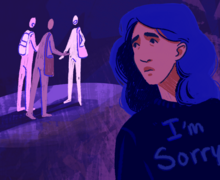Local officials want more bus accessibility for Syracuse city students, but say their hands are tied
Ally Moreo | Photo Editor
The Board of Education and the Syracuse Common Council support a plan that would reduce the “walk zone” to 1 mile for students going to school, but officials say their hands are tied with state restrictions and not enough money.
Jules Nshimiye walked his usual path home from school one day last winter. Past Teall Avenue. Past the mounds of snow that inevitably form during a Syracuse winter. Past the entrance of Lincoln Park, about a mile from Henninger High School. Nshimiye had just finished soccer practice. It was dark and he was alone.
The details of what happened next are fuzzy. Nshimiye remembers walking with his head down past a group of about six or seven men. They yelled at him. Nshimiye is a refugee from Congo and had only been in the United States for about a year. He didn’t fully understand what they were saying, so he responded, “No English.”
What he remembers next is a fist with brass knuckles punching his head, right above his eye. A passerby called 911, and the men scattered.
“I’m losing my memories of it,” said Nshimiye, who was a 15-year-old sophomore at Henninger High School when the incident happened. “It’s not something someone wants to remember.”
Up until a year ago, he would wake up at 5:30 every morning and trek 1.6 miles to and from school, as the city didn’t provide busing to students living closer than 2 miles from school.
That changed after Henninger students formed 2 Miles Too Far, a group focused specifically on getting more buses in the district, so students like Nshimiye don’t have to walk to school. Through protests and pleas at school board meetings from members of 2 Miles Too Far, the distance was eventually lowered to 1.5 miles. The next step is to get the distance lowered even further to 1 mile.

Rachel Sandler | Digital Editor
Busing advocates say harsh winters, often with unshoveled sidewalks along with rising crime and poverty, make walking more than a mile to school difficult and unsafe. This year alone, Syracuse has gotten 100 inches of snow, making it the first large city to do so, according to Syracuse.com. And 2016 was the deadliest year in Syracuse history, with 31 homicides.
“It’s always bothered me,” said Joyce Suslovic, a social studies teacher at Henninger High School and the adviser for the students in 2 Miles Too Far. “(Students) get to school and they’re soaking wet, they’re freezing. You have first graders you can’t see walking between cars in the road because the sidewalks aren’t shoveled. We’ve had students attacked on their way to school.”
The Board of Education and the Syracuse Common Council support a plan that would reduce the “walk zone” to 1 mile, but officials say their hands are tied with state restrictions and not enough money.
“We’re on board, we’re trying to get this done, too,” said Syracuse School Board Commissioner Dan Romeo.
But despite the abundance of political will in the city itself, the district can’t afford to increase transportation for students without state funding.
“The financial reality is that we need money from the state,” Common Councilor Susan Boyle said. “Or without that, we would have to cut funding from programs in the district if we decide that busing is a priority. That money has to come from somewhere.”
In December, the Common Council unanimously voted to ask the state to fund a pilot program that would bus K-12 students living between 1 and 1.5 miles from school.
Boyle said she’s optimistic the district will get the money for K-8 students, but added that convincing the state to give money for high school students may prove more difficult.
“A lot of people think that walking a mile to school as a high schooler isn’t that big of a deal,” she said.
Boyle added the proposal doesn’t include pre-K students. This is because the district already has a grant that could be used for transportation, she said.
The district, too, is making a conservative bet that it will get the money for K-8 students and not high school students, Romeo said. The proposed budget for the next school year includes $4.6 million, which is only enough for K-8 busing.

Ally Moreo | Photo Editor
“So many people just don’t get it that not everyone owns a car or has a parent with a car,” Suslovic said. “What if these lawmakers had to walk home from their meetings? They might understand then.”
Current state law classifies students living closer than 1.5 miles as “non-allowables,” meaning the school district is not required to bus them. Advocates want the state to make an exemption for Syracuse, citing the city’s harsh weather and higher crime and poverty rate than other cities in New York state.
Bill Magnarelli, who represents Syracuse in the New York State Assembly, said he will push for funding and the exemption for the pilot program.
“I am hopeful that I can work with my colleagues to get this issue resolved, and help the students of the Syracuse City School District,” he said in a statement provided to The Daily Orange.
A spokesperson for David Valesky, who represents Syracuse in the New York State Senate, said he was unavailable to comment on the matter.
Published on February 21, 2017 at 10:59 pm
Contact Rachel: rsandler@syr.edu





